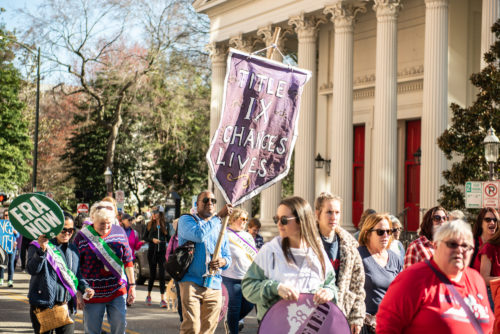Home of the updated U.S. Constitution, starring the 28th Amendment!
“What will the 28th Amendment (Equal Rights) really do?”

- Because the 28th Amendment directly impacts government action, the first cases would focus on gender discrimination by the government and would include protections for LGBTQ+ individuals. These cases could include challenging:
- Employment situations like hiring, firing, advancement, pay equality, medical accommodation, etc. in federal, state, and local government (issue overview, Pew Research Center)
- How our military handles sexual harassment and assaults (issue overview, Military Times)
- Length and availability of paternity leave as compared to maternity leave (issue overview, WhatToExpect.com)
- Inherent discrimination of major backlogs of untested rape kits as well as uninvestigated rapes (issue overview, The Atlantic)
- Significantly higher rates at which women are sent to jail for self-defense (issue overview, The New Yorker)
- Discriminatory medical and safety research protocols (issue overview, National Women’s Law Center)
- Law enforcement not sufficiently trained for addressing gender violence and minimizing / ignoring gender-based crimes (example, Washington Post)
- Gender discrimination experienced by citizens during incarceration (issue overview, ABA Journal)
- Discriminatory implementation of laws regarding sex trafficking (issue overview, Equality Now)
- Discriminatory implementation of nuisance laws and evictions (issue overview, ACLU and The Atlantic)
- Child custody in highly contested divorce cases with domestic violence in the home (issue overview, Stop Abuse Campaign)
- Lack of kits, training, and forensic nurses for sexual assault intake at hospitals (example, ABC News)

- Congress’ legislative capacity to support gender equality in America will be enhanced.
- Section Two of the 28th Amendment (Equal Rights) says: “The Congress shall have the power to enforce, by appropriate legislation, the provisions of this article,” explicitly providing Congress the ability to enact appropriate legislation for gender equality.
- This section mirrors similar wording in other constitutional amendments (13th, 14th, 15th, 19th, 23rd, 24th, and 26th).
- The Constitution limits the powers of what laws Congress can pass. Because we do not explicitly guarantee gender equality in our Constitution (yet) many federal laws needed to protect gender equality do not have a constitutional basis.
- Examples:
- There was a private remedy (financial compensation for a victim) component of the Violence Against Women Act that was struck down by the courts. With the 28th Amendment Congress could add back this private remedy knowing the courts would uphold it as constitutional.
- The 28th Amendment could serve as a basis for enhanced federal legislation against sex trafficking.
- The 28th Amendment could serve as a basis for a national law prohibiting female genital mutilation.
- After the 28th Amendment is enforceable, gender discrimination cases should achieve a success rate similar to race, religion, and country of origin discrimination cases.
- The current standard for race, religion, or country of origin discrimination cases is “strict scrutiny” which provides a 73% likelihood of winning (Source, Tennessee.edu).
- Currently, gender discrimination cases receive “heightened” or “intermediate scrutiny” and because of this the likelihood of winning a case are only 47% (Source, Tennessee.edu).
ADDITIONAL FAQs

































